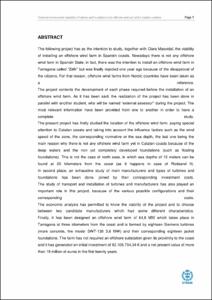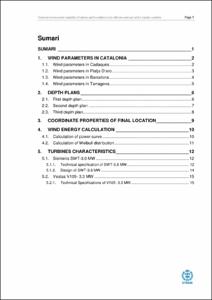Mostra el registre d'ítem simple
Technical and economic feasibility of turbines and foundations of an offshore wind park at the Catalan coastline
| dc.contributor | Gomis Bellmunt, Oriol |
| dc.contributor.author | Esteva Fàbrega, Ariadna |
| dc.contributor.other | Universitat Politècnica de Catalunya. Departament d'Enginyeria Elèctrica |
| dc.coverage.spatial | east=1.2444908999999598; north=41.1188827; name=Via Roma, 2, 43005 Tarragona, Espanya |
| dc.date.accessioned | 2015-01-27T20:24:51Z |
| dc.date.available | 2015-01-27T20:24:51Z |
| dc.date.issued | 2014-06 |
| dc.identifier.uri | http://hdl.handle.net/2099.1/24788 |
| dc.description.abstract | The following project has as the intention to study, together with Clara Masvidal, the viability of installing an offshore wind farm in Spanish coasts. Nowadays there is not any offshore wind farm in Spanish State; in fact, there was the intention to install an offshore wind farm in Tarragona called “Zèfir” but was finally rejected one year ago because of the disapproval of the citizens. For that reason, offshore wind farms from Nordic countries have been taken as a reference. The project contents the development of each phase required before the installation of an offshore wind farm. As it has been said, the realization of the project has been done in parallel with another student, who will be named “external assessor” during the project. The most relevant information have been provided from one to another in order to have a complete study. The present project has firstly studied the location of the offshore wind farm, paying special attention to Catalan coasts and taking into account the influence factors such as the wind speed of the zone, the corresponding normative or the sea depth, the last one being the main reason why there is not any offshore wind farm yet in Catalan coasts because of the deep waters and the non yet completely developed foundations (such as floating foundations). This is not the case of north seas, in which sea depths of 12 meters can be found at 20 kilometers from the coast (as it happens in case of Rodsand II). In second place, an exhaustive study of main manufacturers and types of turbines and foundations has been done, joined by their corresponding investment costs. The study of transport and installation of turbines and manufacturers has also played an important role in this project, because of the various possible configurations and their corresponding costs. The economic analysis has permitted to know the viability of the project and to choose between two candidate manufacturers which had some different characteristics. Finally, it has been designed an offshore wind farm of 64,8 MW which takes place in Tarragona at three kilometers from the coast and is formed by eighteen Siemens turbines (more concrete, the model SWT-120 3,6 MW) and their corresponding eighteen jacket foundations. The farm has not required an offshore substation given its proximity to the coast and it has generated an initial investment of 92.106.704,34 € and a net present value of more than 19 million of euros in the first twenty years. |
| dc.language.iso | eng |
| dc.publisher | Universitat Politècnica de Catalunya |
| dc.rights | Attribution-NonCommercial-NoDerivs 3.0 Spain |
| dc.rights.uri | http://creativecommons.org/licenses/by-nc-nd/3.0/es/ |
| dc.subject | Àrees temàtiques de la UPC::Energies::Energia eòlica::Parcs eòlics |
| dc.subject.lcsh | Wind power plants -- Design and construction -- Catalonia |
| dc.title | Technical and economic feasibility of turbines and foundations of an offshore wind park at the Catalan coastline |
| dc.type | Bachelor thesis |
| dc.subject.lemac | Parcs eòlics -- Projectes i construcció -- Catalunya |
| dc.rights.access | Open Access |
| dc.audience.educationlevel | Grau |
| dc.audience.mediator | Escola Tècnica Superior d'Enginyeria Industrial de Barcelona |
| dc.audience.degree | GRAU EN ENGINYERIA EN TECNOLOGIES INDUSTRIALS (Pla 2010) |



